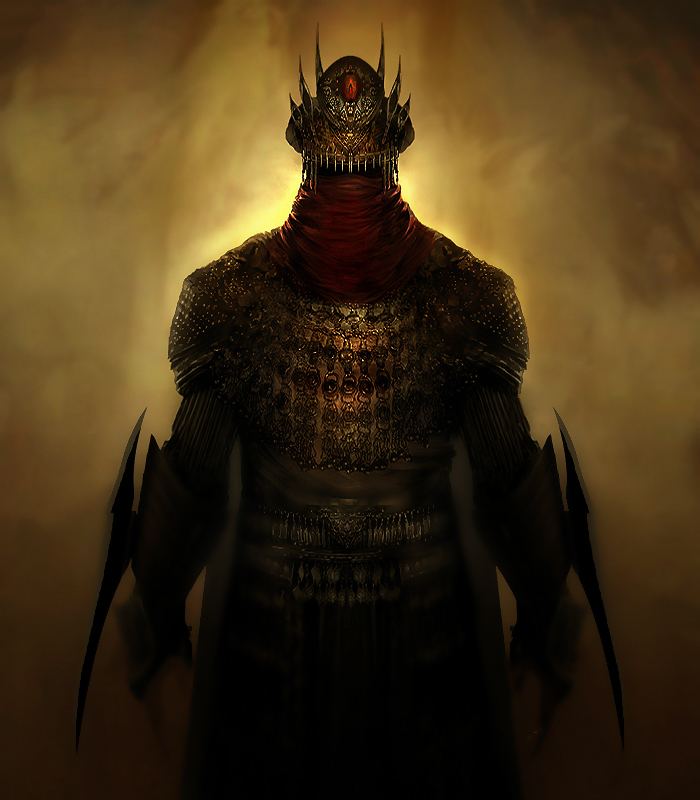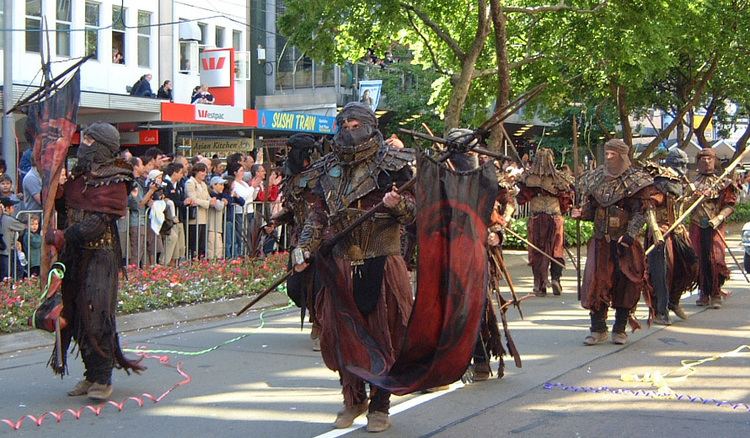Other name(s) Haradwaith, Sunlands | ||
 | ||
Type Vast hot region with deserts and jungles Notable locations Near Harad, Umbar, Far Harad First appearance | ||
In J. R. R. Tolkien's epic fantasy legendarium detailing lands within Middle-earth, Harad - or more formally the Harad - was the name for the immense lands south of Gondor and Mordor. In the languages invented by Tolkien, Harad means South in Sindarin, and it was named Hyarmen in Quenya with the same meaning. It is also referred to as the Sunlands, and as Haradwaith (from the people who lived there; the name literally means "South-folk", from the Sindarin harad, "South" and gwaith, "people").
Contents

Harad benefits
Middle-earth narrative
Aragorn's brief description of Haradwaith - "Harad where the stars are strange" - suggests that Harad is close to or in the southern hemisphere, as the world is a globe by the time of The Lord of the Rings and not flat as it was before the Fall of Númenor.
Geography and fauna
Harad had jungle and desert regions. In its jungles lived apes, and animals known as mûmakil, which were elephant-like but larger and more aggressive.
The great harbour and city of Umbar was situated on Harad's west coast, which was washed by the Great Sea.
To the north of Harad lay (west to east) the lands of Gondor, Mordor and Khand. Historically the border with Gondor was held to be the river Harnen, but by the time of the War of the Ring all the land further north to the river Poros was under the influence of the Haradrim. The border with Mordor ran along the southern Mountains of Shadow.
The Harad Road was the main overland route between Gondor and Harad. From Gondor's point of view, Harad was divided into the regions of Near Harad and Far Harad.
Haradrim
[1] The Men of Harad were called Haradrim, "South-multitude", or Southrons. "Haradrim" was merely a Gondorian generic description of any of the men that came from south of their borders. The Haradrim were a collection of proud and warlike races. They were a race of Men and could be extremely unpredictable, especially with the war mumak of Harad.
Harad's tribes included into those of Near and Far Harad, although there were many tribes of the Haradrim, often mutually hostile. Some of the peoples of Far Harad were organized into kingdoms.
During the Second Age the Haradrim first came into contact with the Men of Númenor, a great island-nation apart from Middle-earth. At first, the Númenoreans came as friends and teachers, but later the Kings of Númenor grew hungry for wealth and power and established territories in Middle-earth. They built a great city in the firth of Umbar, a vast natural harbour on the southern shores of the Bay of Belfalas, and eventually turned the city into a fortified citadel from whose gates they levied great tributes upon the tribes of Harad. Many of the Haradrim were killed or sold into slavery.
From the latter part of the Second Age Númenóreans dominated many of the Men of Harad as well as many other peoples whose lands included a coastline. Shortly before the War of the Last Alliance, two Númenórean lords, named as Herumor and Fuinur, "rose to great power amongst the Haradrim", but their ultimate fate is not recorded.
For many centuries of the Third Age, many Haradrim were still ruled by Black Númenórean Lords, or further north by the Kings of Gondor. But ultimately Harad fell under the influence of Mordor for much of the Age. The Haradrim began to cooperate with the Corsairs of Umbar increasingly from 1540 onwards, and were joined by the Corsairs for the Battle of Pellenor Fields.
At the time of the War of the Ring, the Southrons were in league with Sauron and fought alongside his orc army, riding atop gigantic, elephantine beasts called mûmakil. One of the leaders of the Haradrim at the time of the War of the Ring bore a standard of a black serpent on a red field; King Théoden of Rohan slew him at the Battle of the Pelennor Fields in T.A. 3019.
After the revival of the Reunited Kingdom of Gondor and Arnor in the Fourth Age, peace was made with Harad.
The appearance of the Haradrim is somewhat ambiguous, but The Two Towers gives relatively detailed descriptions of at least some of them. Frodo and Sam encounter Faramir and his Rangers of Ithilien just before the latter ambush a company of Haradrim on the North Road. Frodo and Sam do not see much of the battle, since they are positioned elsewhere, but they hear the sounds of fighting, and a slain Harad warrior crashes at their feet. He is described as having brown skin, with black plaits of hair braided with gold. He wears a scarlet tunic, as do the other Haradrim, and a gold collar. He is armed with a scimitar and garbed with a corslet of brazen scales. Here Sam experiences his moment of empathy; also here they see a mûmak, to Sam's terror and delight. Later, men of Far Harad are described as black-skinned, but there is also a group of them described as "black men like half-trolls with white eyes and red tongues" and "troll-men". It is unclear whether these were just large Men who are being compared to Trolls or some sort of crossbreed between the two races. Supporters of the latter interpretation point to the similar terms "half-orcs" and "goblin-men", appearing in the same book (chiefly in the second volume, The Two Towers), and "Orc-men" and "Man-orcs", appearing in later writings (published in Morgoth's Ring) — all applied to the products of Sauron and Saruman's Orc/Man breeding programmes.
Language
Tolkien did not specifically work out a particular language for the Haradrim. The only word which is stated to come from a southron language is "Mûmak", the name of the great war-oliphaunts of Harad. Gandalf states that his name in "the south" is "Incánus" (which is Latin, meaning "very grey-haired" and thus may be simply a translation of the original Olórin's name among the Haradrim, just like name "Gandalf" itself is an anglicized Old Norse translation of a Westron), thought by some to be a Haradrim name, but speculated by Tolkien to actually be a Westron or Sindarin form from Gondor. On early sketches for The Lord of the Rings, names as "Barangils" and "Harwan" appear, but it is uncertain if Tolkien intended both to be names from a Haradrim language. Despite having a meaning in Quenya ("fate"), the name Umbar is said to be adapted from the natives' language and not from Elvish or Adûnaic.
In other media
In Peter Jackson's The Lord of the Rings film trilogy the Haradrim are inspired visually by Aztecs and Pacific Kiribati tribes (rather than an unspecified African influence as in the book) according to the ROTK DVD's Weta Workshop documentary. The Haradrim here fight only from the backs of the Mûmakil, having no cavalry or foot-soldiers as in the book, nor are the associated "half-trolls" or variags of Khand portrayed on film. The apparent leader of the Haradrim force is killed in the film not by Théoden, but by Éomer. They appear in much merchandise for the film trilogy, such as toys, The Lord of the Rings Trading Card Game, and the computer game The Lord of the Rings: The Battle for Middle-earth II. They also appear as "Haradrim Slayers" in the computer game, The Lord of the Rings: War of the Ring.
In the movie, Faramir (rather than Sam, as in the book) comments on a dead Southron, philosophizing whether the soldier was actually evil or just goaded or blackmailed into serving the enemy. This was partly to establish Faramir's character in the movie as having more empathy than his proud brother, Boromir. The original line from the novel is frequently cited by Tolkien fans as arguing against perceived racism in the work, a more common topic of discussion in recent years.
The Middle-earth Role Playing game and the Lord of the Rings Strategy Battle Game, the latter based on Peter Jackson's The Lord of the Rings film trilogy, both include original material about Harad and the Haradrim. In the former, the Haradrim language is called "Haradaic". In the latter the leader Théoden kills is called "Suladân the Serpent Lord", its forces include assassins called "hasharin", and other names such as "Dalamyr", "Kârna", "Badharkân", "Hidâr", "Nâfarat", "Abrakân", and "Dhâran-Sar" appear. The conceit of Harad representing some African or Arabian equivalent (being south of Middle-earth as "Europe") is more explicit in these materials; most of these original names have no relation to Tolkien's writings, and some, such as "hasharin", are actually Arabic words.
